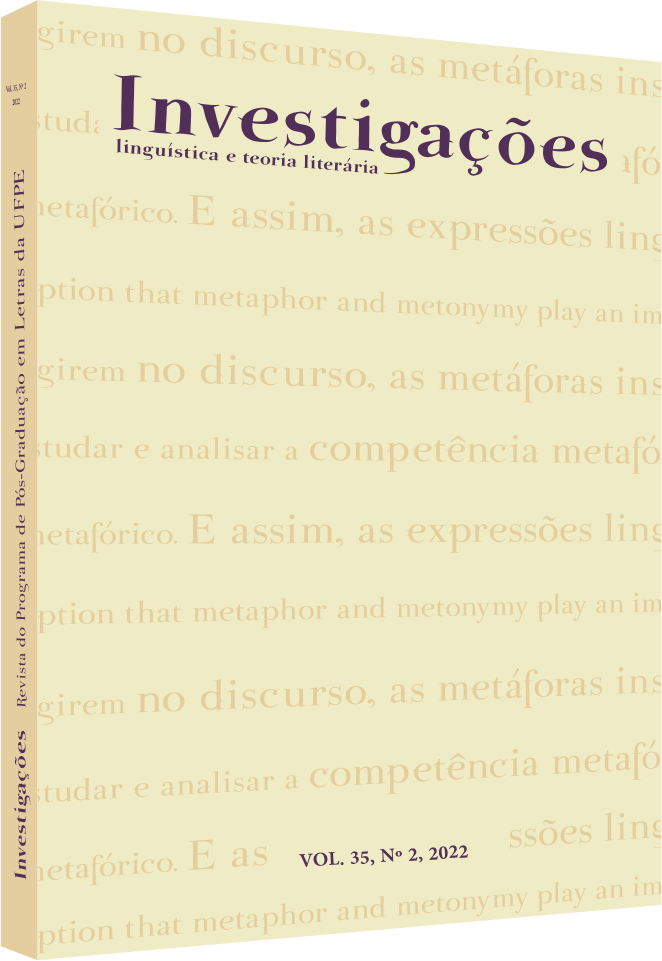Os efeitos do silêncio da ministra Damares Alves
DOI:
https://doi.org/10.51359/2175-294x.2022.254284Keywords:
twitter, violence against women, rumor, the art of being silent.Abstract
This article explores, through concepts and theoretical frameworks of digital discourse analysis, the meanings Damares Alves’s silence, as Minister of State, at the launch of the campaign “Enfrentamento à Violência Contra a Mulher”, in November 2019. The concept of constitutive silence (ORLANDI, 2007) in which Damares's can be understood as a simulacrum with the contours of performance. The corpus was composed from publications on the official account of the minister (@DamaresAlves), on Twitter. We seek to address the effects of meaning when different discursive formations meant the silence of the minister.References
ALVES, Damares. “Ninguém entendeu meu silêncio, mas agora eu explico pra vocês. Denuncie a violência contra a mulher. Ligue 180. #vctemvoz”. Brasília, 25nov. 2019, 15:41. Twitter: @DamaresAlves. Disponível em: https://Twitter.com/DamaresAlves/status/1199042712550461441 Acesso em: 28 abr. 2021.
BECK, Maurício. Apraxia e silenciar: formas resistência-revolta por meio de uma subtração subjetiva. In: História das ideias: nos domínios da língua(gem). Revista Conexão Letras, Porto Alegre, v. 8, n. 10, p. 71-82, 2013.
BECK, Maurício; FONSECA, Rodrigo Oliveira; SANTOS, Aretuza Pereira dos. Recortes discursivos, paradigma indiciário e procedimentos contraindutivos. Revista Linguagem em (Dis)curso, Tubarão, v. 19, n. 1, p. 153-171, jan./abr. 2019.
DIAS, Cristiane. A análise do discurso digital: um campo de questões. Revista Redisco, Vitória da Conquista, v. 10, n. 2, p.8-20, jul./dez. 2016.
DINOUART, Josep-Antoine-Toussaint. A arte de calar. Tradução Luiz P. Ribeiro. São Paulo: Martins Fontes, 2002.
GRIGOLETTO, Marisa. Silenciamento e memória: discurso e colonização britânica na índia. In: Discurso, língua e memória. Revista Organon, Porto Alegre, v. 17, n. 35, p. 229-243, jun. 2003.
INDURSKY, Freda. A fala dos quarteis e as outras vozes. 2. ed. Campinas: Editora Unicamp, 2013.
INSTITUTO DE PESQUISA ECONÔMICA APLICADA (IPEA). Atlas da violência 2020. In: Portal Atlas da violência, online, 2020. Disponível em: https://www.ipea.gov.br/atlasviolencia/arquivos/artigos/3519-atlasdaviolencia2020completo.pdf Acesso em: 16 nov. 2021.
LEITÃO, Matheus. Silêncio em coletiva foi ideia da própria Damares em reunião com assessores próximos. Portal G1, online, 2019. Disponível em: https://g1.globo.com/politica/blog/matheus-leitao/post/2019/11/26/ideia-de-ficar-em-silencio-em-coletiva-partiu-de-damares-em-reuniao-com-assessores-mais-proximos.ghtml. Acesso em: 16 nov. 2021.
ORLANDI, Eni. As formas do silêncio: no movimento dos sentidos. Campinas: Editora da Unicamp, 2007.
PAVEAU, Marie-Anne. [Dictionnaire] Composite. Technologies discursives [Carnet de recherche], 2015. Disponível em: http://technodiscours.hypotheses.org/?p=699 Acesso em: 30 abr. 2021.
PÊCHEUX, Michel. Papel da memória. In: ACHARD, P. et al. (Org.) Papel da memória. Tradução e introdução José Horta Nunes. Campinas: Pontes, 1999.
PÊCHEUX, Michel. Semântica e discurso: uma crítica à afirmação do óbvio. Tradução Eni Pulcinelli Orlandi, Lorenço Chacon J. filho, Manoel Luiz Gonçalves Corrêa e Silvana M. Serrani, 5. ed. Campinas: Editora da Unicamp, 2014.
SCHNEIDERS, Caroline Mallmann. Do retorno ao arquivo à constituição do corpus e dos gestos de interpretação. In: A noção de arquivo em Análise do Discurso: relações e desdobramentos. Revista Conexão Letras, Porto Alegre, v. 9, n. 11, p. 99-109, 2014.
SILVEIRA, Juliana da. Rumor(es) e humor(es) na circulação de hashtags do discurso político ordinário no Twitter. 2015. 210f. Tese (Doutorado em Letras) – Programa de Pós-Graduação em Letras, Universidade Estadual de Maringá, Maringá, 2015.
Downloads
Published
How to Cite
Issue
Section
License
Copyright (c) 2022 Ciro Antônio das Mercês Carvalho, Elisiane Santos de Matos, Maurício Beck

This work is licensed under a Creative Commons Attribution 4.0 International License.
Authors who publish with Revista Investigações agree to the following terms:
Authors retain copyright and grant the journal right of first publication with the work simultaneously licensed under the Creative Commons Attribution 4.0 International (CC BY 4.0) license that allows others to share the work with an acknowledgement of the work's authorship and initial publication in this journal.
Authors are able to enter into separate, additional contractual arrangements for the non-exclusive distribution of the journal's published version of the work (e.g., post it to an institutional repository or publish it in a book), with an acknowledgement of its initial publication in this journal.
You are free to:
Share — copy and redistribute the material in any medium or format for any purpose, even commercially.
Adapt — remix, transform, and build upon the material for any purpose, even commercially.
The licensor cannot revoke these freedoms as long as you follow the license terms.
Under the following terms:
Attribution — You must give appropriate credit , provide a link to the license, and indicate if changes were made . You may do so in any reasonable manner, but not in any way that suggests the licensor endorses you or your use.
No additional restrictions — You may not apply legal terms or technological measures that legally restrict others from doing anything the license permits.

